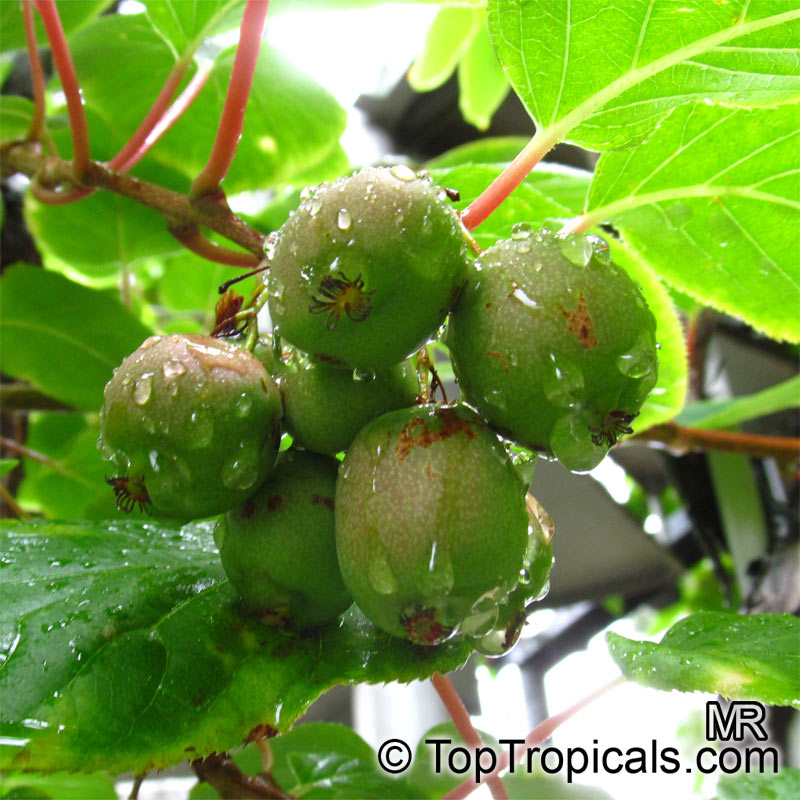Actinidia arguta - Hardy Mini Kiwi Prolific
6684 Actinidia arguta - Hardy Mini Kiwi Prolific










The Hardy Mini Kiwi Prolific can bear fruit the first year after planting. It produces smooth-skinned fruit the size of large grapes in late summer to early fall, great for fresh eating, salads, dessert or jelly. Kiwi plants are attractive growers that require a sunny location, preferably with wind protection. They can be grown in different types of soils; however, the soil must be well drained. Kiwi plants are very pretty when used to cover a wall or fence or used in landscape design. Less aggressive than other kiwi varieties, Prolific is easily trained and ideal for trellises or fences.
Recommended Fertilizer: SUNSHINE C-Cibus - Crop Nutrition Booster
SUNSHINE-Honey - sugar booster
Actinidia arguta - Hardy Mini Kiwi Prolific: Planting and Care Instructions
Plant Overview
Growth habit: This plant grows as a vine or creeper. It likes to climb or spread out, so it does well on trellises, fences, or along the ground. It can also be grown in a container with a support structure, making it suitable for patios or small spaces.
Growing conditions: This plant can be grown outdoors in the suitable USDA zone. It is well-suited for small backyards, pots, or indoor spaces with enough light.
Watering: This plant does best with moderate to regular watering. Water it regularly, but let the top layer dry slightly between waterings.
Sun exposure: This plant grows well in both full sun and semi-shade. If kept indoors, give it as much light as possible for best growth.
USDA Zone: Zone 9-11. The USDA Plant Hardiness Zone Map categorizes North America into zones based on average annual minimum winter temperatures, each differing by 10 °F. This map serves as a basic guide for selecting appropriate plants for a region. However, it's not definitive; plant varieties vary in cold tolerance, and young plants typically need more protection. Additionally, local microclimates, like sheltered areas or sunny spots, can influence plant health and survivability beyond the general zone recommendation.
Hardiness: Light freezing, 30°F for short period of time, mature plants. Young plants must be protected. Plant hardiness indicates the coldest temperature a mature plant can endure briefly while staying healthy. This rating is a guideline and can vary among varieties of the same species. Young plants often need more cold protection. Additionally, a plant's survival can be enhanced by the microclimate of its location, which may provide shelter from wind or extra warmth, allowing it to thrive beyond its typical hardiness range.
Plant type: This is a fruit tree. With proper care, it will grow tasty delicious delicious fruits.
Flower color: This plant produces white and off-white flowers during its blooming season.
Deciduous plant: This is a deciduous plant, meaning it sheds its leaves seasonally. During the winter period, it may appear bare or dormant, but this is a natural part of its cycle. Minimal watering and protection from extreme cold may be needed, depending on the plant and climate.
Ethnomedicinal: This plant has ethnomedical uses and has been traditionally valued in folk or indigenous medicine. Plants marked as ethnomedical and/or described as medicinal are not offered as medicine but rather as ornamentals or plant collectibles. Ethnomedical statements or products have not been evaluated by the FDA and are not intended to diagnose, treat, cure, or prevent any disease. All customers should consult a physician before using any supplements, herbals, or medicines.
Outdoor planting
Select a planting spot that fits the plant sun and moisture needs. Loosen the soil and mix in compost or organic matter to improve poor soil. Dig a hole just slightly larger than the root ball and avoid planting deeper than it was before. For better drainage, the top of the root ball can sit slightly above the surrounding soil. Provide temporary shade at first if conditions are hot or sunny. Water regularly and monitor soil moisture until the plant is well rooted. nAdd mulch around the base to keep the soil moist and reduce weeds. Shape the mulch to form a shallow basin for water, but keep mulch away from the stem.
Indoor planting
Use a container with drainage holes and a well-draining potting mix. Position the plant so that the top of the root ball is level with the surface of the soil - avoid planting too deep. A slow-release fertilizer can be mixed into the soil at planting time to support healthy growth. Place the plant in a location that matches its light needs, and water according to its care requirements. Be careful not to overwater, and ensure good airflow around the plant to reduce the risk of pests and disease.
Protecting Plants in Winter
When it gets cold, some plants need extra help. You can move potted plants indoors or under a covered patio. Young plants need extra protection because they are more sensitive to cold and less established. For plants in the ground, use frost cloth to keep them warm. Stop using fertilizer in late fall so plants can rest. Try to place plants in areas protected from cold wind, rain, and frost.
Cold Hardiness and Microclimates
USDA zone and hardiness are only general guidelines. Actual cold tolerance can vary based on plant variety and local conditions. Even small differences between varieties can matter. Also, warmer spots in your yard—like near a wall or fence—can help plants survive cold nights. These little warm areas are called microclimates, and they make a big difference.
